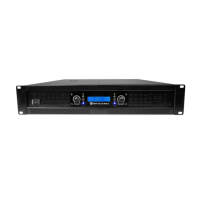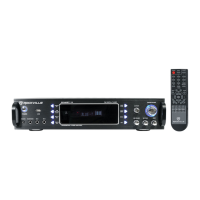4
“ARVA” - AUTOMATIC RAIL VOLTAGE ADJUSTMENT
CIRCUITRY:
Rockville RX Phenom Series ampliers feature “ARVA” circuitry in their power supply. This circuit
constantly monitors the output stage and under high current demands will adjust the power supply
rail voltages so that enough power is available for peak situations. The “ARVA” also improves the
damping factor of the amplier when playing low impedance mono loads. Rockville RX Phenom
Series ampliers have tighter sounding bass reproduction thanks to this unique circuitry.
BATTERY VOLTAGE:
Rockville RX Phenom Series ampliers are rated and regulated to 13.8 volts and below. Increasing
voltage to 14.4 volts will increase the power output of the amplier in the same proportion. Maximum
input voltage is 14.4 volts while the minimum voltage is 12 volts.
*** DO NOT EXCEED 14.4 INPUT VOLTAGE. ***
Though capable of high power reproduction, Rockville RX Phenom Series ampliers are not
competition style ampliers! They were designed for audiophile sound reproduction.
PROTECTION CIRCUITRY:
Rockville ampliers incorporate many outstanding protection circuits to help protect the amplier
from being damaged during operating conditions.
Thermal Protection: When the amplier reaches an unsafe operating temperature of 80 degrees
Celsius the amplier will turn o. Once the amplier cools down, simply reset the amplier by its
Remote connection, (turn the amplier o and then on again once you have given the amplier a
chance to cool down) and the amp will once again begin to play.
If you live in a hot climate we suggest installing additional cooling fans in your trunk to
exhaust the hot air which can build up in the trunk this will help keep the ambient temperature
in the trunk as low as possible so that your amps work awlessly and without any
musical interruption.
Speaker Short Circuit Protection: Should your speakers short circuit due to voice coil burn out, or should
the amplier sense an impedance too low to handle, the Protection LED will light, indicating a diagnostic
condition. Turn o your system, disconnect one speaker at a time and try to determine which speaker might
be faulty. Correct the condition and restart the amplier. You must reset the amplier by turning it OFF and
then ON again by the Remote power connection after correcting a diagnostic condition. (Turn your radio o
and then on again.)
Clipping or total shutdown may also be a result of a bad ground connection or loose
ground. If you nd that your speakers and speaker wires are not shorted, please check
your ground connection.
Input Overload Protection: This circuit will either shutdown the amplier completely
or make the amplier spurt on and o indicating that it is in a diagnostic condition. Turn
the system o and reduce the gain on the amplier or volume from your head unit, this
should result in a corrected condition.
DC Oset Protection: Should any DC voltage try to enter the amplier via the speaker
terminals it will cause the amplier to shut down and not operate until this condition is
remedied. This circuit will also protect damaging high DC voltages from reaching your
speakers should your amplier ever malfunction.
INSTALLATION BASICS:
Before you begin with your installation, disconnect the NEGATIVE (-) terminal from your
car’s battery. This safety precaution will avoid possible short circuits while wiring your
amplier. Rockville ampliers operate on 12-volt negative ground systems only.
It is recommend that you layout your sound system design on paper rst. This will help
you during the installation so that you will have a wiring ow chart and not miss-wire any
of your components.
Mount the amplier in the trunk or hatch area of your vehicle. Never install an amplier
in the engine compartment or on the rewall. Please be sure to leave breathing room
around the amplier heat sink so that it can dissipate the heat it produces eciently. The
amplier can be installed either horizontally or vertically.
When mounting the amplier on the trunk oor, be sure to watch for your gas tank, gas
lines and electrical lines. Do not drill or mount any screws where they might penetrate
the gas tank of your car.
Features

